Schedule
0900 hrs. to 1700 hrs.
Saturday 17th & Sunday 18th of March 2018
Venue
Art of Sport, Emotion Center, B5/28, opp. Deer Park, Safdarjung Enclave
Workshop Fee: Rs. 4,000.00
Registration Deadline: 7th March 2018
Participant Capacity: 15
Apply on: mail@designpendulum.com
ABOUT:
image:medium:actor are hands-on multimedia workshops on creative processes. Four fundamental and comprehensive mediums of theater, graphics, text and collage constitute the workshops, which are open to all irrespective of age and educational background, just as creativity is accessible to all irrespective of our artistic and technical inclinations.
Emphasizing on emotions as the primary ingredients and produce of the creative process, the workshops regard memories as the beehive for the honey of emotions. The workshops are hands-on, focusing on the body as the primary medium and preventing (as far as possible) any hardware or software from interfering with a direct engagement in the creative pursuit.
Initiated in 2011 image:medium:actor has been conducted in various formats ranging from two to four days, to a fortnight long module to a weekly elective across a semester. NID & CEPT in Ahemdabad, KRVIA & JJ in Mumbai, and AVANI in Kozhikode are some of the institutions which have been hosts to the workshops.
THE CREATIVE PROCESS
Image is the instigator; its purpose is to move me to pursue it. But it’s beyond my reach: too far, too fast, too frightening, too fragile. I choose a medium to help me in the pursuit – something that’ll help me cover the distance in good speed, help calm the fears/ and or allow me to hold the delicate image with care. Since it isn’t sure whether the image is amorphous or polymorphous, I may need more than one medium. And I am the actor, the interpreter defining the relevance of the mediums and driving the manifestation of the image.
The image, the medium and the actor are the three principal protagonists of the narrative of the creative process. How exactly does this story unfold though? It definitely isn’t a circus where the ring master whips the mighty lion to jump through a ring. Quite often the creative process ends up frustrated because the actor, in his obsession with manifesting the image in its incomplete form, whips the life out of the medium and ends up with all three protagonists deflated. A medium is not a mould to cast an image. The success of a mould is in its capacity to produce innumerable replicas. Replicas, however, are either inanimate or the lack of diversity makes clones vulnerable to annihilation when faced with severe adversities. Treating institutions and our relationships as moulds causes great grief. Instead, the medium need be consider like a frame which holds a picture that isn’t clearly visible yet. Each – the frame and the picture – would acquire an identity in relation to the other and yet retain autonomy such that the two are not agonizingly bound to each other. What allows for this autonomy is the threshold: the discernible space between the two (which has to be negligible in the case of a mould and its cast).
The threshold carries the disparity between the imagined and the experienced. We subconsciously presume before engaging in even the most mundane of activities. For instance, approaching the door of a new place one is about to enter: how heavy or light would it be? Is it to be pushed in or pulled out? Will the handle be too cold to hold? All questions and pre-calculations are answered the moment the door is engaged with. The gap between the anticipation and the actual throws up surprises evoking emotions in us. It is the emotional fluctuation which facilitates the precipitation of a memory of the experience. The threshold – the hotbed of emotions – therefore is vital to the creative process: bringing in all the learning and establishing memories of the creative experience. For what are we without memories but a bag of flesh for bones, and what are we without our stories but disposable batteries fit for clones.
CONCEPTS
The workshop touches upon various necessary aspects of the creative process:
Curiosity is what fuels the process. One has to be eager to find – that is the minimum requirement. Trying to find only because you’ve been told to is being in a job and not in a creative process.
Conversations are indispensible to the creative pursuit: to be present and attentive rather than preoccupied and distracted, to seek and discover rather than prove and convince, and to show up, iterate and reiterate rather than wait for the magical stroke of genius. It demands earnest regard for one’s self, to begin with, then for the medium chosen for putting the idea to test. Respect for one’s work is vital, only then can it feed the conversation with another individual or other people, and get enriched and robust with multiple perspectives.
Appropriation is the inevitable act of taking an existing idea (since we aren’t the first here) and making it one’s own (with due credit, as opposed to misappropriation/ plagiarism) in order to better it (since we aren’t the last ones either).
Abstraction as the skill of extracting knowledge from one context for application in another is critical for any learning to qualify as such. Abstraction is the building block of knowledge of any kind and nature.
Translation from one form to another – whether it is language or medium – is vital to the creative pursuit: aspects hidden in one are disclosed in another, dead-ends confronted in one can be broken through with another. It is only through multidisciplinary engagements that we can attempt to fulfill our multidimensional personae.
Collaboration is essential in all human endeavors and more so in creative processes. We don’t operate in vacuum. We are both impacted by and influence our environments. Would it not help manifest greater meanings if we were to acknowledge collaboration as the way to work? Not in opposition to the individual’s solitary study but in addition to it; the ascetic has to come out of his cave and engage with the world.
Embodiment is how memory resides. Consider the continual repetitive drills of a sportsperson in order to perfect her craft. Compared to this, the proliferation of the innumerable external storage devices, which we pretend to be capturing our memories in, is adversely interfering with our experiences. Remembering is an act of re-construction, discovering – as you assemble – the actual emotions that allowed the experience to precipitate. It is perhaps more important to seek the root of emotions from an experience rather than the authenticity of the episode itself.
Resourcefulness keeps the light of creativity burning. Each individual is the greatest resource in her own pursuit. In spite of all the self doubts, we need to believe in our own worth to be able to create meaning; we need to believe that we are good enough to be able to keep moving without the fear of failure. We have to do with what we have.
OUTCOMES OF THE WORKSHOP
Besides an introduction to the necessary soft skills for a better presence and future, the workshop presents the participants with a fresh perspective on their own strengths and limitations. The processes also suggest how participants can build upon what they are good at and repair what may be broken or navigate around what they may not be ready to take on yet.
Vulnerability is a tremendously potent state if we can see it as being open to the new, unfamiliar and (therefore) uncomfortable. To be able to grow, it is necessary to feed our desire to venture into the unknown while trusting our instinct for self-preservation without succumbing to paralyzing insecurities. While the workshop emphasizes this, it also, more importantly, brings about a realization in every participant that the other participants are as vulnerable in their own struggles: trying and failing, yet trying again.
In material terms, the participants churn out surprising amount of work which is disproportionately large considering the time invested. The works are both individual and collective and almost always in unusual form and media.
NOTE ON THE DIRECTOR
 I am a New Delhi-based practicing architect, designer and animateur. Besides image:medium:actor, I run compoundeye – a visual communication design enterprise – and also head, along with my wife & partner Sukhmani Brar, the spatial design firm Design Pendulum.
I am a New Delhi-based practicing architect, designer and animateur. Besides image:medium:actor, I run compoundeye – a visual communication design enterprise – and also head, along with my wife & partner Sukhmani Brar, the spatial design firm Design Pendulum.
Body, space, time, emotions and material form the components of my work as an architect, designer and animateur. We need to create stories to create memories to create meaning.
















